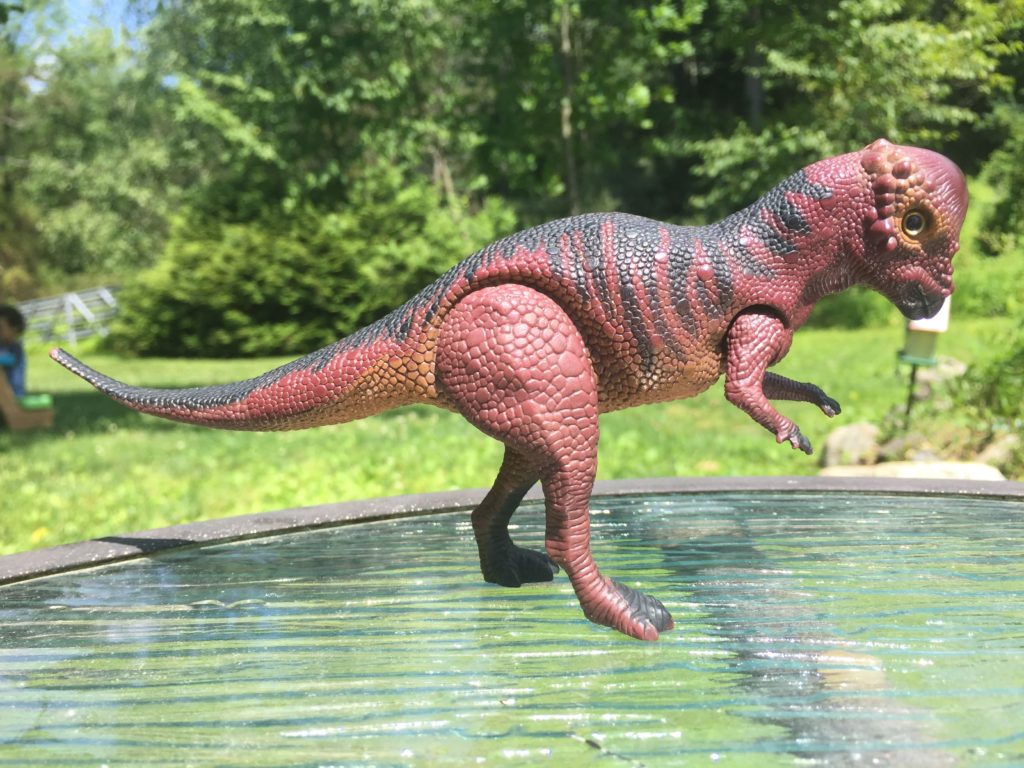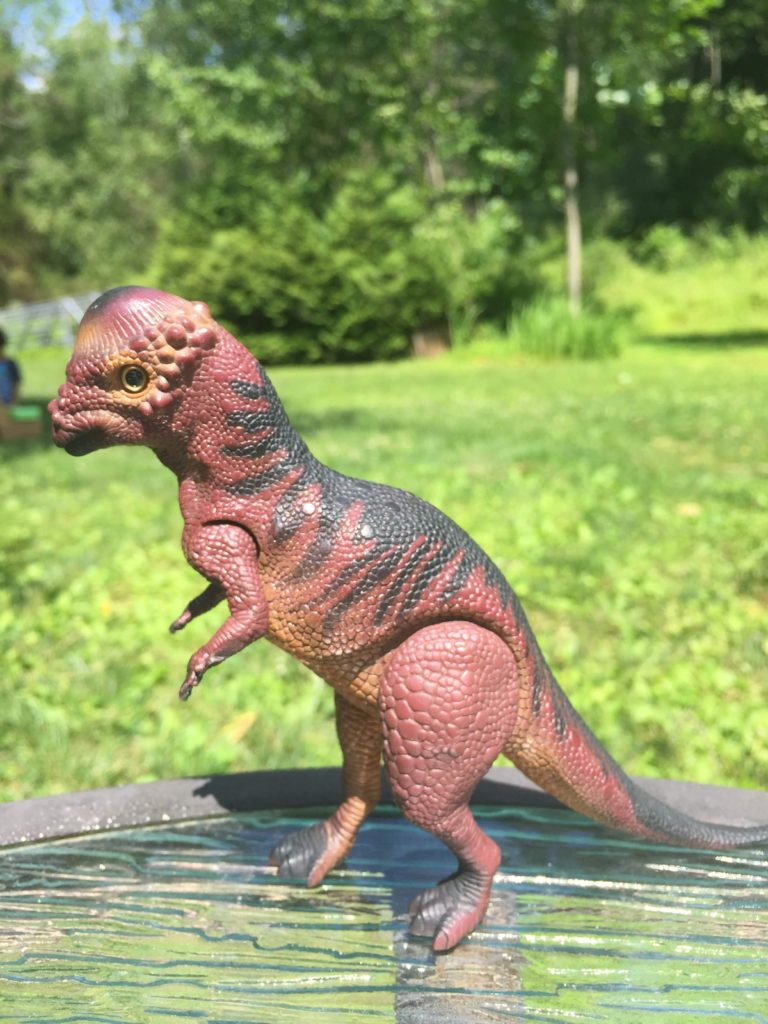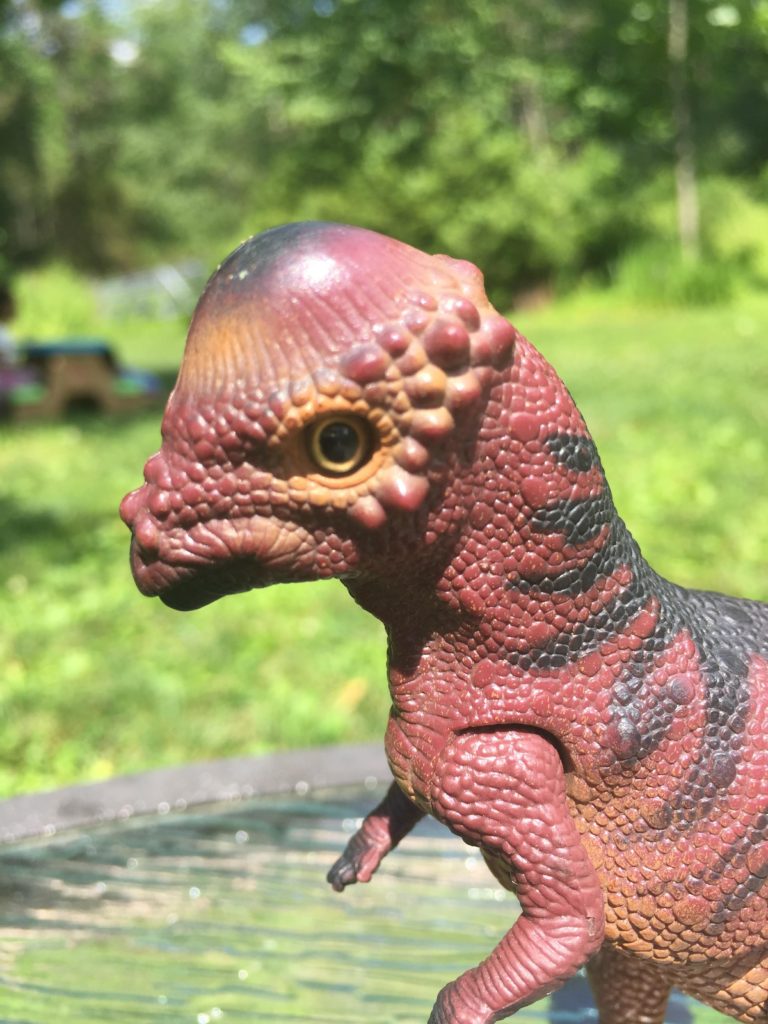Review and images by dinoguy2, edited by Suspsy
I knew I had a box full of Dino-Riders toys somewhere, and when it was rediscovered recently I was excited to take a fresh look at some of these 1980s’ era dinosaur figures, especially those I remembered as being ahead of their time. The feathered Struthiomimus, the Czerkas-esque Kentrosaurus, and very natural-looking (rather than monstrous) Placerias, Dimetrodon, and Saurolophus. But one figure that had slipped my mind was the Pachycephalosaurus. So it was a nice surprise when I dug this one out and discovered how awesome it is. The sculpt on this thing is phenomenal, with scales so real-looking you might confuse it for a living, breathing reptile. But how accurate is it, held up to our current knowledge of pachycephalosaur biology?

Strictly speaking, adult Pachycephalosaurus are known primarily from remains of their skulls, and this was doubly true in the 1980s’, before more specimens like the subadult “Sandy” were discovered. One of the best known skulls is the partially reconstructed AMNH 1696 on display at the American Museum of Natural History in New York. This would have been the skull the toy sculptors had to work with as a reference. While they did okay overall, note that the spiky snout region should probably be longer and narrower. The toy’s head is fairly stubby and triangular in comparison, and it doesn’t have enough spikes, nor are they large enough (keratin would have made them look even bigger in life). The dome is appropriately high, rounded, and broad, but the eye is probably a little too big compared to the orbit, and doesn’t leave much room for a sclerotic ring. The head is appropriately beaked and has cheeks, which is debatable, but in line with the thinking at the time.

The Pachycephalosaurus measures 21 cm long. Its body proportions look pretty good compared to the Sandy specimen, though that is a subadult. It should probably be a bit broader and more barrel-chested, but really, the highlight here are the scales, which are beautifully sculpted. The figure has four points of articulation, with separately mobile swivel joints at each limb. The arms are very small with four stubby little fingers each, though the wrists are pronated. The feet have four weight-bearing toes, with the inner toe set back from the others, which is weirdly therizinosaur-like. In reality, the inner toe would have been more of a dewclaw. The musculature across the whole body is noticeably sculpted, particularly on the legs and neck. This thing has the neck of a pro wrestler, with bulging muscles on both sides.

The tail is interesting because it is both broad and flattened. If it were a little less flat, it would be a great example of current thinking on dinosaur tail musculature. Pachycephalosaurs do have very wide, side-projecting processes on the vertebrae close to the torso, which is where this interpretation likely came from. The tail should just be way rounder in all dimensions (this is a critique based on new data though – even in a project with as much attention to detail as the Saurian game, you could see an evolution in pachycephalosaur tail shape between the early concept art, which resembled this figure in the tail area, to the final product).

As for the posture, the figure can stand either in the old-school tripod, or in a more modern-looking, tail-up configuration (though it’s a little tricky to get it to balance in the latter). I suspect this latter pose was made possible for the purposes of making it capable of head-butting, and the tail sits at a weird angle when displayed this way, so I actually prefer the classic, if outdated, stance.
Combined with the nice maroon and black striped pattern giving way to burnt orange on the belly, the individually sculpted scales add a beautiful illusion of realism. I say “illusion” because there is no doubt these scales are way too large compared to the body size, with the possible exception of the scute-like belly scales which may actually be fairly accurate by today’s standards. Accurate or not, the overall effect looks great, like the hide of a living, breathing lizard. Unfortunately, this effect doesn’t quite extend onto the minimally painted hind limb flanks, which are also made of a softer, duller plastic than the body. The neck looks great, with powerful muscles visible, the kind you’d expect would be great for supporting a head-butting contest.

Overall, this is a great toy, and it’s surprising that such a quality figure in terms of color scheme, detail, and realism was part of a fairly low-priced action toy line. It’s definitely one of the best-looking figures in the line, and though it has a few outdated areas, the sculpt and paint job look good enough that it still deserves a place on the shelf alongside more modern dinosaur figures.
Disclaimer: links to Ebay and Amazon on the DinoToyBlog are affiliate links, so we make a small commission if you use them. Thanks for supporting us!



Torn between love and hate.
Colors definitely remind me of the Kenner one though that one came later. Nice review and figure too.
I never appreciated how truly good this toy really is until now—terrific review!